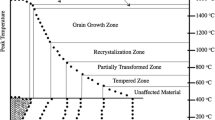Abstract
The goal of this study was to develop a mathematical model which incorporates heat flow, phase transformation kinetics, and property-structure-composition relationships to predict the mechanical properties of steel rod being control cooled under industrial conditions. Thus, the principles of microstructural engineering have been brought to bear on this interdisciplinary problem by combining computer modeling with laboratory measurements of heat flow, austenite decomposition kinetics, microstructure and mechanical properties, and industrial trials to determine heat transfer and obtain rod samples under known conditions. Owing to the length and diversity of the study, it is reported in three parts,[8191]the first of which is concerned with the heat flow measurements. A relatively simple and reliable technique, involving a preheated steel rod instrumented with a thermocouple secured at its centerline, has been devised to determine the cooling rate in different regions of the moving bed of rod loops on an operating Stelmor line. The measured thermal response of the rod has been analyzed by two transient conduction models (lumped and distributed parameter, respectively) to yield overall heat-transfer coefficients for radiation and convection. The adequacy of the technique has been checked by cooling instrumented rods under well-defined, air crossflow conditions in the laboratory and comparing measured heat-transfer coefficients to values predicted from well-established equations. The industrial thermal measurements have permitted the characterization of a coefficient to account for radiative interaction among adjacent rod loops near the edge and at the center of the bed.
Similar content being viewed by others
Abbreviations
- Bi :
-
Biot number
- C :
-
empirical constant used in Eq. [5]
- C p :
-
specific heat, J kg-1 ‡C-1
- D :
-
rod diameter, m
- F :
-
radiation factor in Eq. [4]
- h :
-
heat-transfer coefficient, W m"2 ‡C~’
- h c :
-
heat-transfer coefficient due to convection, W m-2 ‡C-1
- hov :
-
overall heat-transfer coefficient, W m2 ‡C-1
- h R :
-
heat-transfer coefficient due to radiation, W m-2 ‡C-1
- k :
-
thermal conductivity, W m-1 ‡C
- Nu:
-
Nusselt number
- Pr:
-
Prandtl number
- q TR :
-
rate of heat release during phase transformation, W
- r :
-
radial position, m
- r 0 :
-
rod radius, m
- R :
-
radiation correction factor
- R c :
-
radiation correction factor for center of the Stelmor line
- R E :
-
radiation correction factor for edge of the Stelmor line
- Re:
-
Reynolds number
- t :
-
time, s
- T :
-
temperature, K or ‡C
- T A :
-
ambient temperature, K or ‡C
- T o :
-
initial temperature, K or ‡C
- T s :
-
surface temperature, K or ‡C
- x :
-
empirical constant used in Eq. [5] and symbol denoting undercooling, ‡C, in Eqs. [10] and [11]
- y :
-
empirical constant used in Eq. [5]
- ρ:
-
density, kg m-3
- Σ :
-
Stefan-Boltzman constant, 5.67 10-8 W m-2 K-4
- ε:
-
emissivity
- Μ :
-
kinematic viscosity, m2 s-1
- v :
-
air velocity, m s-1
References
J.K. Brimacombe, E.B. Hawbolt, I.V. Samarasekera, P.C. Campbell, and C. Devadas: inProc. Thermec ’88, I. Tamura, ed., Iron and Steel Institute of Japan, Tokyo, pp. 783–90.
A. Tendier:Wire J., 1981, vol. 14, pp. 84–91.
J. Tominaga, K. Matsuoka, and S. Inoue:Wire J. Int., 1985, vol. 18, pp. 62–72.
P. Bercy, U.G. Boel, N. Lambert, and M. Economopoulos:Metall. Plant Technol., 1984, vol. 4, pp. 46–51.
A.A. Jalil:Iron Steel Eng., 1982, vol. 59, pp. 46–48.
G.H. Geiger and D.R. Poirier:Transport Phenomena in Metallurgy, Addison-Wesley, Reading, MA, 1973, pp. 367–69.
F. Kreith and W.Z. Black:Basic Heat Transfer, Harper and Row, New York, NY, 1980, pp. 249–51.
CO. Bennett and J.E. Myers:Momentum, Heat and Mass Transfer, McGraw-Hill, New York, NY, 1974, pp. 381–83.
Chemical Engineer’s Handbook, J.H. Perry, ed., McGraw-Hill, New York, NY, 1969, pp. 10.13–10.15.
A.J. Mehta and G.H. Geiger:Mechanical Working and Steel Processing Conf. XV, ISS-AIME, Pittsburgh, PA, 1977, pp. 458–82.
Y. Hanada, K. Ueno, A. Noda, H. Kondoh, T. Sakamoto, and K. Mine:Kawasaki Steel Technical Report, 1986, vol. 15, pp. 50–57.
J. Iyer, J.K. Brimacombe, and E.B. Hawbolt:Mechanical Working and Steel Processing Conf. XXII, ISS, Pittsburgh, PA, 1984, pp. 47–58.
P.C. Campbell: Ph.D. Thesis, The University of British Columbia, Vancouver, 1989.
F. Kreith:Principles of Heat Transfer, 3rd ed., Intext Educational Publishers, New York, NY, 1973, p. 140.
British Iron and Steel Research Association:Physical Constants of Some Commercial Steels at Elevated Temperatures, Butterworth’s Scientific Publications, Guildford, Surrey, United Kingdom, 1953, pp. 3–14.
I. Barin, O. Knacke, and O. Kubaschewski:Thermochemical Properties of Inorganic Substances; Supplement, Springer-Verlag, New York, NY, 1977, pp. 245–46.
JANAF Thermochemical Tables, The Thermal Research Laboratory, Dow Chemical Company, Midland, MI, 1960.
P.C. Campbell, E.B. Hawbolt, and J.K. Brimacombe:Metall. Trans. A, 1991, vol. 22A, pp. 2779–90.
P.C. Campbell, E.B. Hawbolt, and J.K. Brimacombe:Metall. Trans. A, 1991, vol. 22A, pp. 2791–2805.
Author information
Authors and Affiliations
Additional information
Formerly Graduate Student, The University of British Columbia.
Rights and permissions
About this article
Cite this article
Campbell, P.C., Hawbolt, E.B. & Brimacombe, J.K. Microstructural engineering applied to the controlled cooling of steel wire rod: Part I. Experimental design and heat transfer. Metall Trans A 22, 2769–2778 (1991). https://doi.org/10.1007/BF02851371
Received:
Issue Date:
DOI: https://doi.org/10.1007/BF02851371




